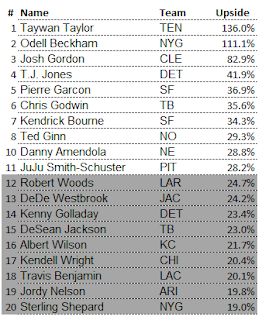It's Been a Long Time, I Shouldn't Have Left You...
After a brief hiatus (rough month at work), it's back to business! And business is booming! While others are coming out with NCAA boards for the April 2019 NFL Player Draft, I will actually LET THEM PLAY before I start that process. In the meantime, let's turn to the Varsity circuit and check out what NFL wide receivers have the most "upside" based on last years statistics.
What's Up, Doc?
Upside is a widely used and very vague term, in many cases. In our case, we will quantify it via analysis of the following metrics:
- Percentage of Team Offensive Snaps Taken (OST)
- Percentage of Targets to Offensive Snaps Taken (T/OST)
- The two above are compared to provide a Confidence Factor (more on that below)
- Yards per Target (YPT)
- Yards per Snap (YPS)
- Each of the previous two are compared to the sample average for YPT/Avg and YPS/Avg.
To be considered for the Upside List, a receiver's 2017 OST needed to be no lower than 1 standard deviation from the mean.
Confidence Factor
A player didn't need to have monster stats in 2017 to give us a glimpse as to the confidence his coaches and QB have in him. But when you have mega-star receivers all over the highlights, how do we find the next potential big thing flying below the radar?
A player's OST can be deceiving. He could be on the field for 80% or more of his team's offensive snaps but not have a number meaningful of targets. So the Confidence Factor puts a player's Percentage of Targets to Offensive Snaps Taken (T/OST) in context of his OST.
For example:
Cleveland Brown WR Josh Gordon lined up for 259 snaps in 2017 which was only 24.2% of the Team's Total Offensive Snaps. By contrast, Rashard Higgins lined up for 664 snaps or 62.1% of team offensive snaps, more than any other Browns' WR in '17. However, we see the difference in rate of T/OST: Higgins saw passes on 7.53% of his snaps while Gordon was targeted 16.60% of his snaps. The large difference in OST for each player greatly impacts the Confidence Factor:
Higgins: OST: 62.10%, T/OST: 7.53% = Confidence Factor of 12.13%.
Gordon: OST:24.2%, T/OST: 16.60% = Confidence Factor of 68.60%.
Here are players with Confidence Factor rates better then the 26.2% average (compared to the final qualifying group):
Comments:
- OK, so the other Giants had to be secretly happy Beckham got hurt in 2017; dude got all the balls when he lined up.
- Taywan Taylor...just remember that name for now...
- Not shown above but the Bottom 10 of qualifying WRs includes Marvin Jones of Detroit who lead all WRs with lining up on 96.30% of the Lions' offensive plays, came in 2nd to LAST in Confidence Factor of a measily 11.1%, getting targeted < 11% of the time he's out there. Mr. Jones brought in over 1,000 yards so from a production standpoint, he was fine. He just may want to make sure they remember he's out there.
So, the above tells us the confidence a team has in their WRs. But is there anything else we can review to support why that confidence is invested? Let's take a stab at that.
Yardage Ratios
The standard yardage ratios, YPT and YPS are not new, but just using the ratios in our effort to refine the Confidence Factor rankings is pretty pointless. Sure Beckham generated 7.37 yards/target and 1.42 yards per snap, but how do we apply that to CF? As raw numbers, they are not very helpful, but once we calculate the YPS/Avg and YPT/Avg, we can then add the impact of these numbers to our overall CF.
Very exciting to see lots of 1st and 2nd year talent in the list, above for YPT/Avg. Now here is the data for YPS/Avg:
Final Player Upside Measure
Given the above (Confidence Factor, YPT/Avg and YPS/Avg), we can calculate an "Upside Measure" to determine which players despite having below average OST are performing well with the opportunities available.
 |
- While all the players above were above average compared to the population, #12-20 were below average compared to the final qualifying group.
- There is Taywan Taylor, leading the pack. His upside compared to the rest of the top performers is ridiculous.
- When you eliminate OBJ and Gordon (whose upside is not questioned), who were eligible because their T/OST ratios were impacted by games missed, Taylor'sUpside is more than 3X that of the next closest challenger in T.J. Jones of Detroit.
- Despite their upside, the following players have potential issues this upcoming season in terms of emerging as a leading WR:
- QB Situation: Gordon (CLE) and Nelson (ARI) may be breaking in rookie QBs (Mayfield and Rosen, respectively) while Godwin and Jackson will have to deal with a backup for the first 3 games given the suspension of Jameis "Mr. Krabbs" Winston.
- Competition: The Detroit and Jacksonville receiving corps here pretty even in terms of the underlying ratios that make up our key metrics above. Given the competition and return of the veteran QB, Jones, Golladay, (both DET) and Westbrook (JAX) will have to continue to elevate their games to fight for targets on a team with no real dominant WR in that respect.
Conclusion
It will be interesting to see how this concept of Upside will pan out going forward as I continue to work to validate the theory through actual results going forward as well as back testing with historical archived statistics. More on the latter will be presented in the coming weeks.
Shameless Self-Promotion!!!
Follow me on Twitter @boombearjr
or at my Facebook page: Boombearjr Football Analysis (also @boombearjr).
Continue to watch this space for more NFL Draft commentary.



No comments:
Post a Comment